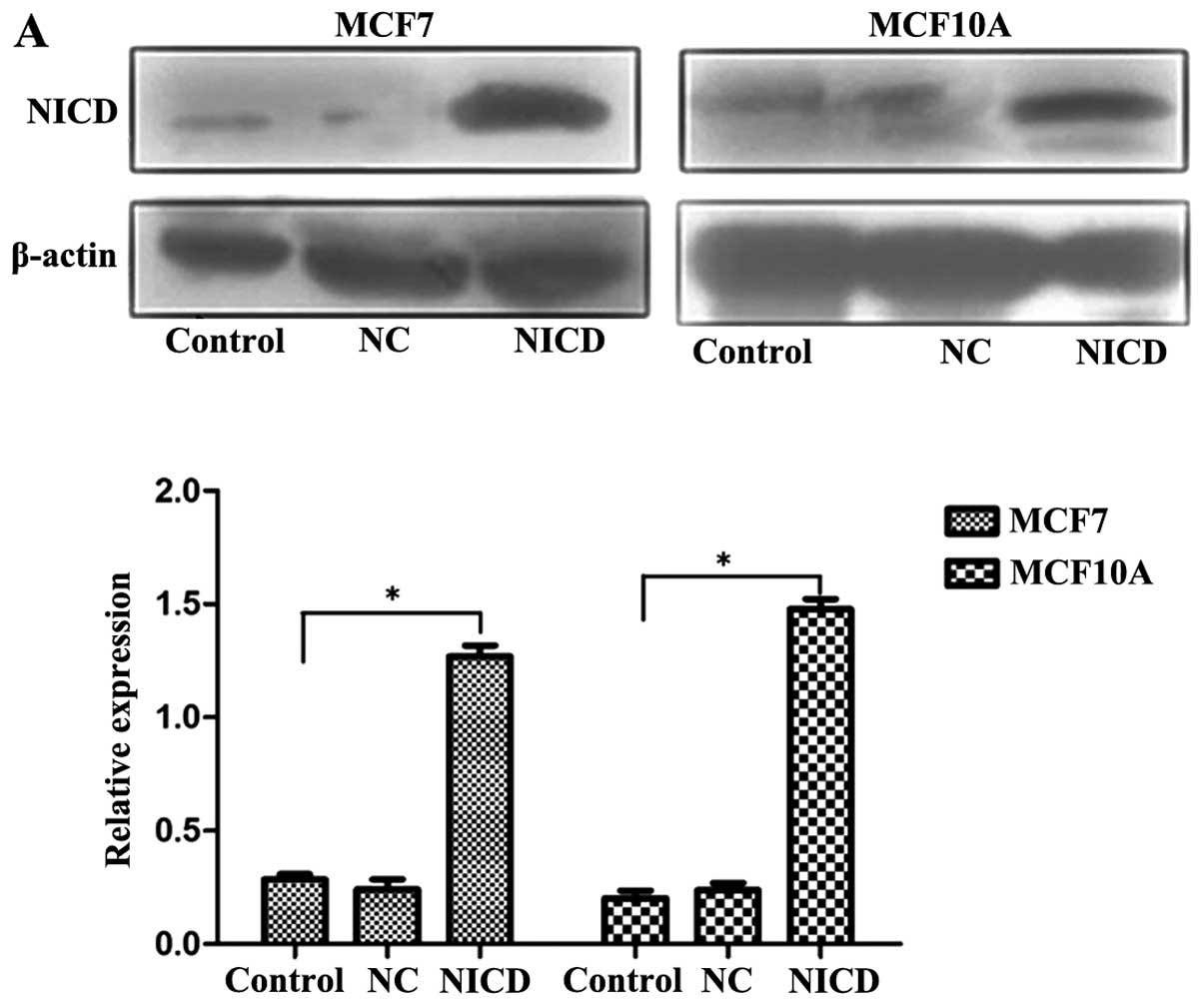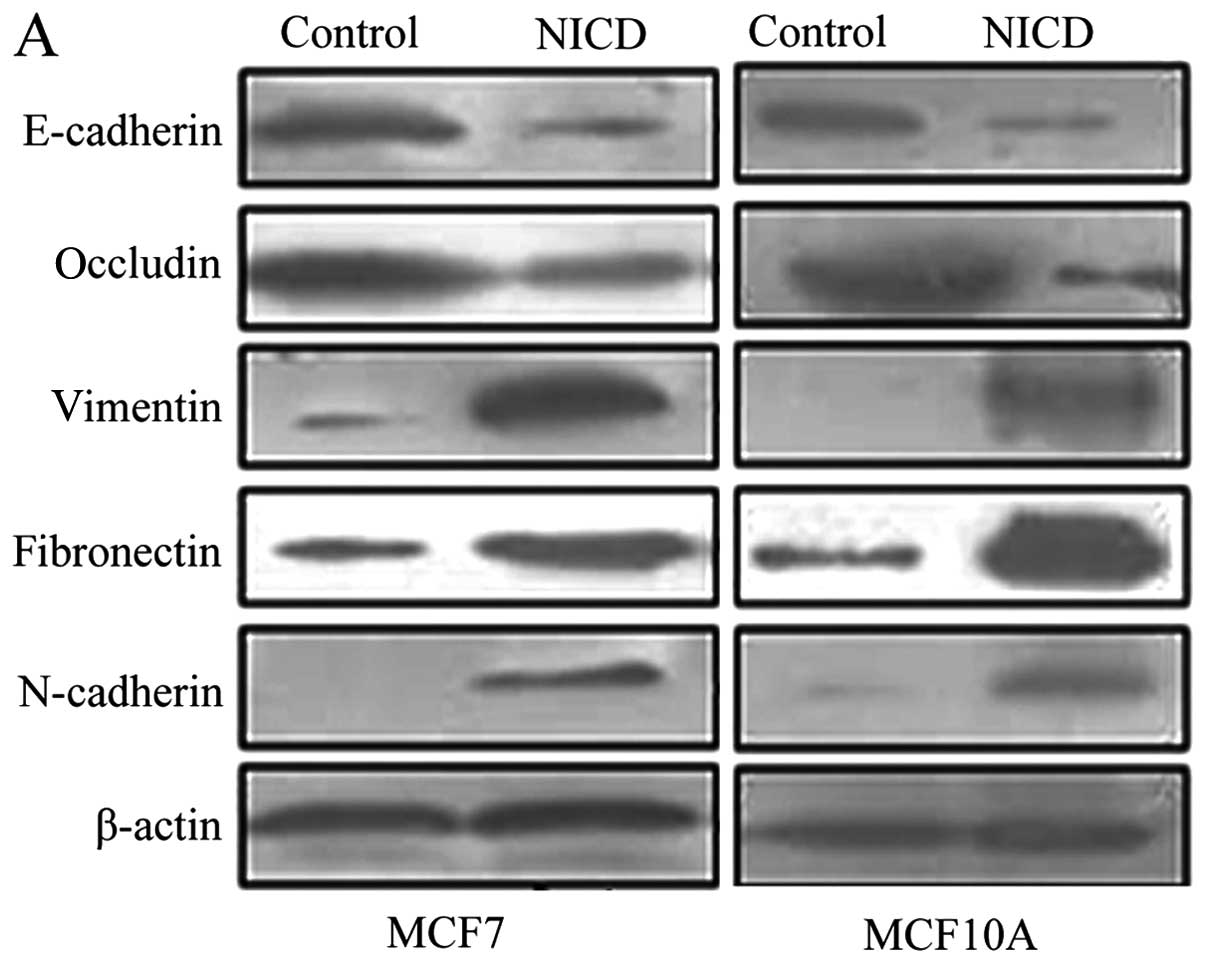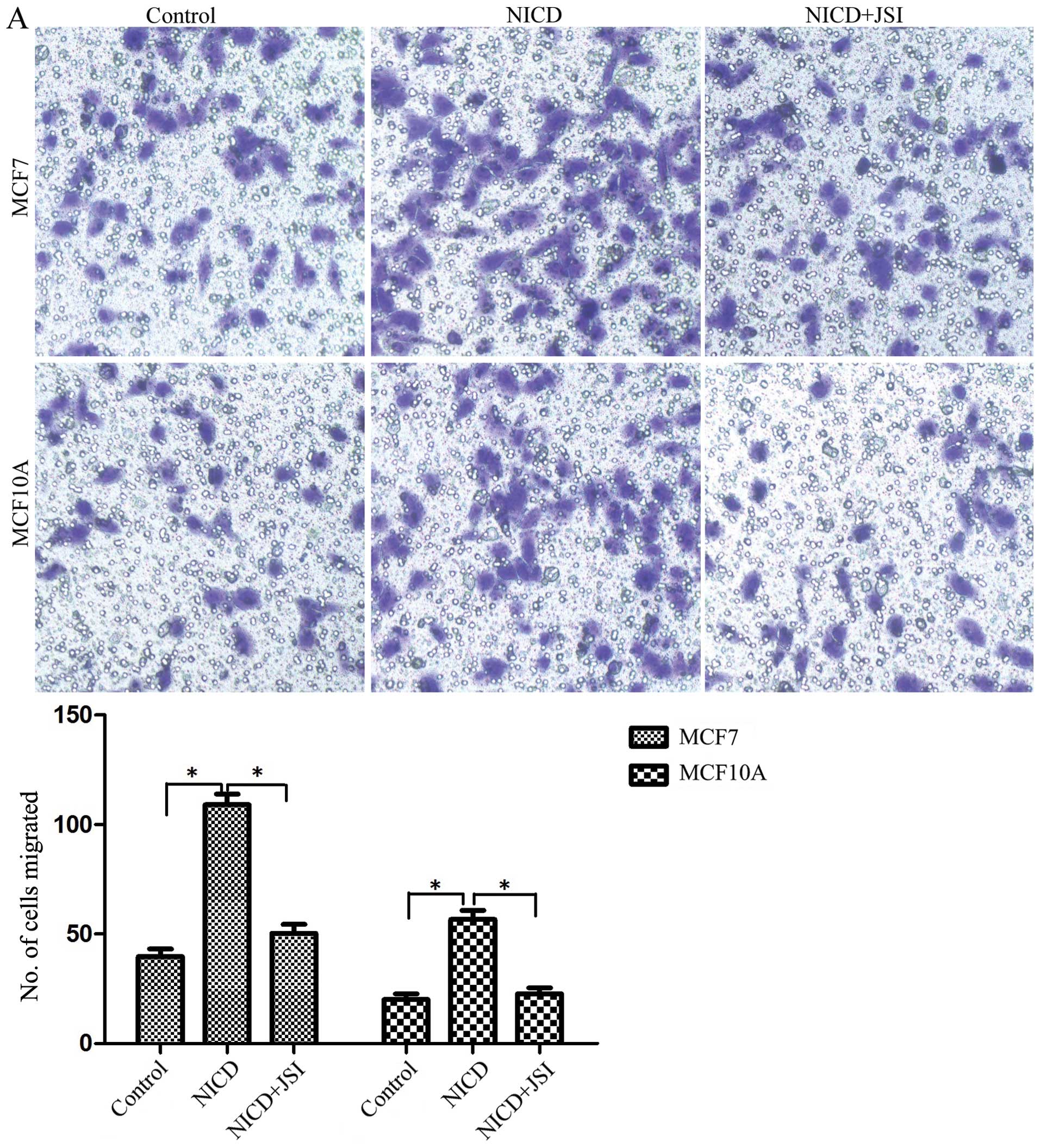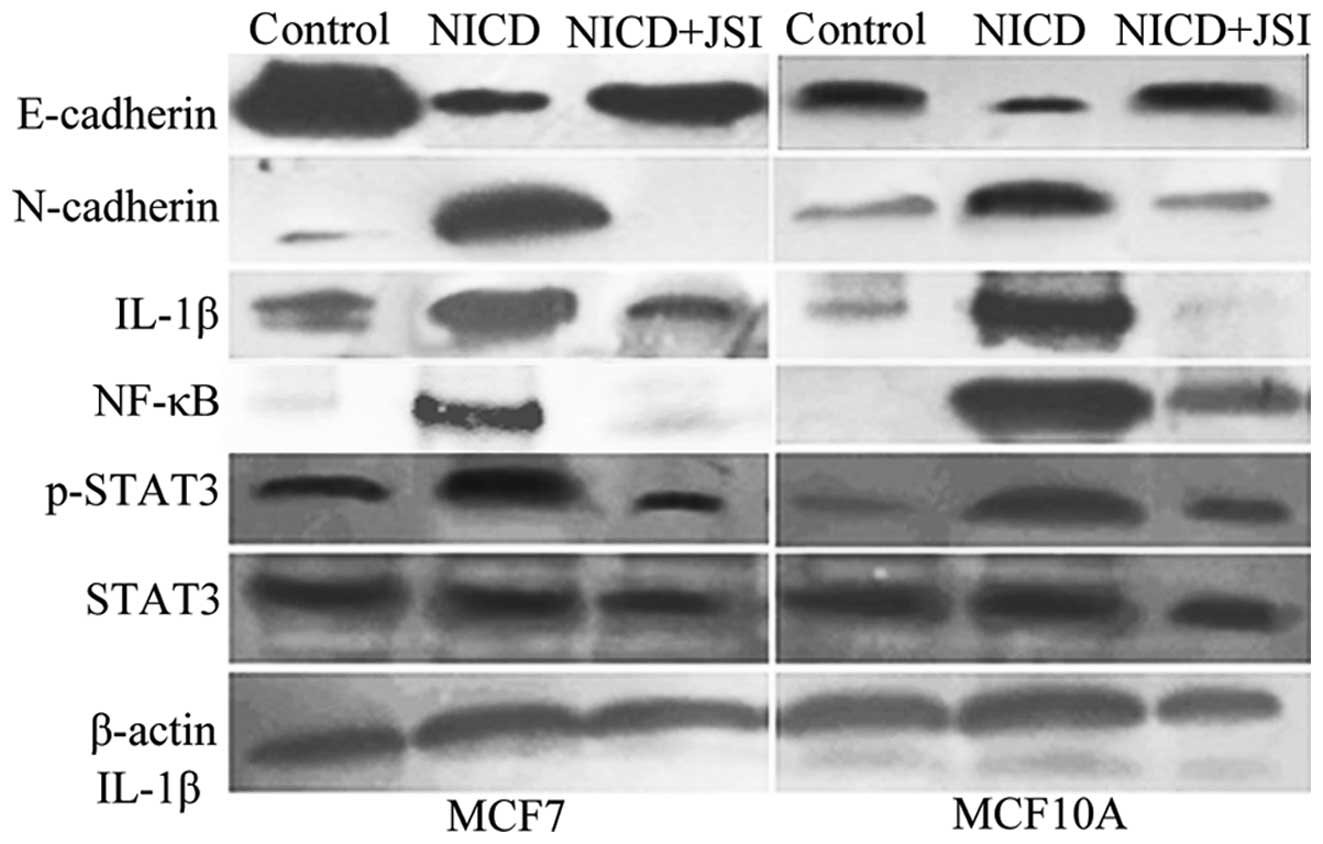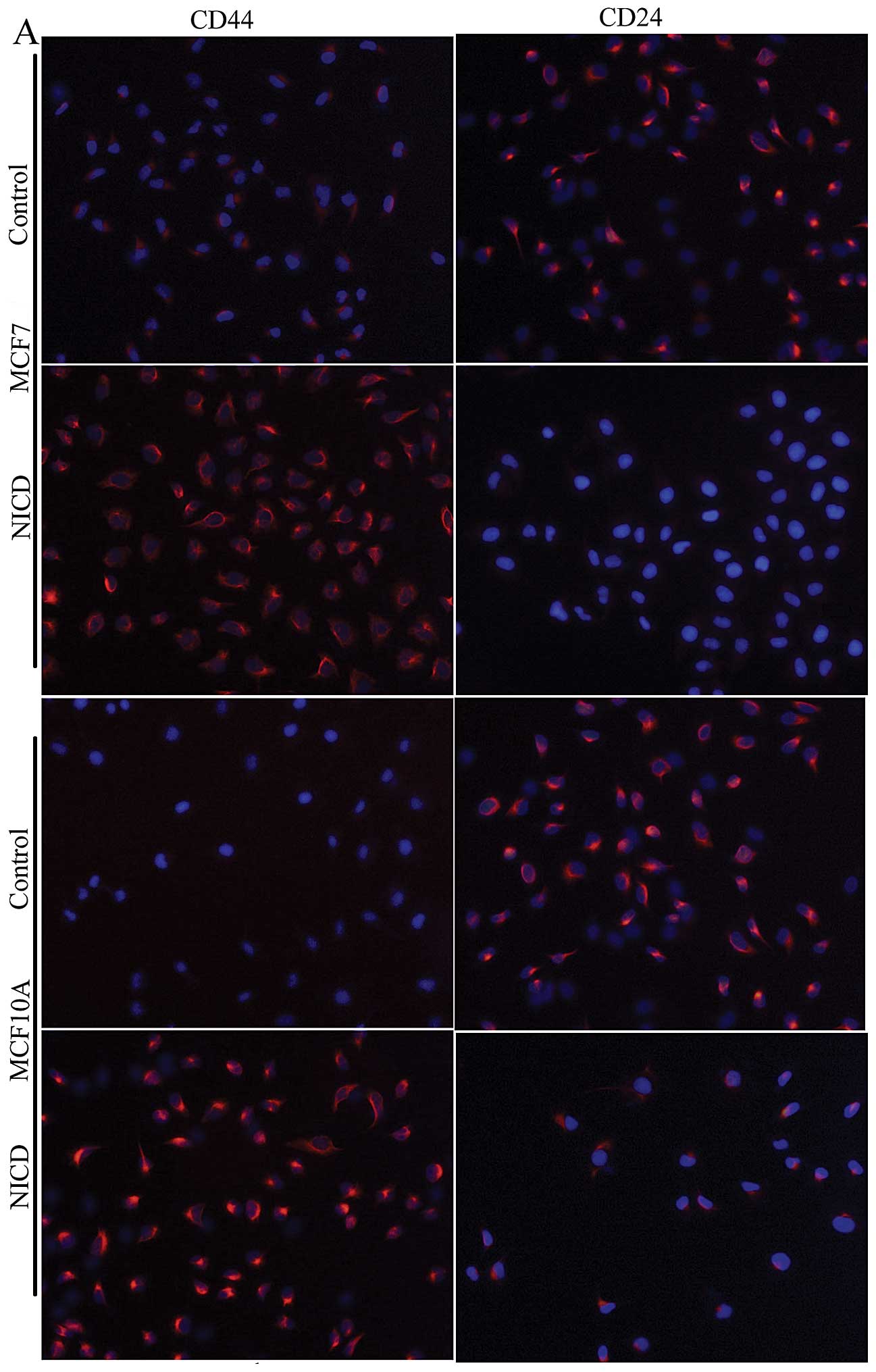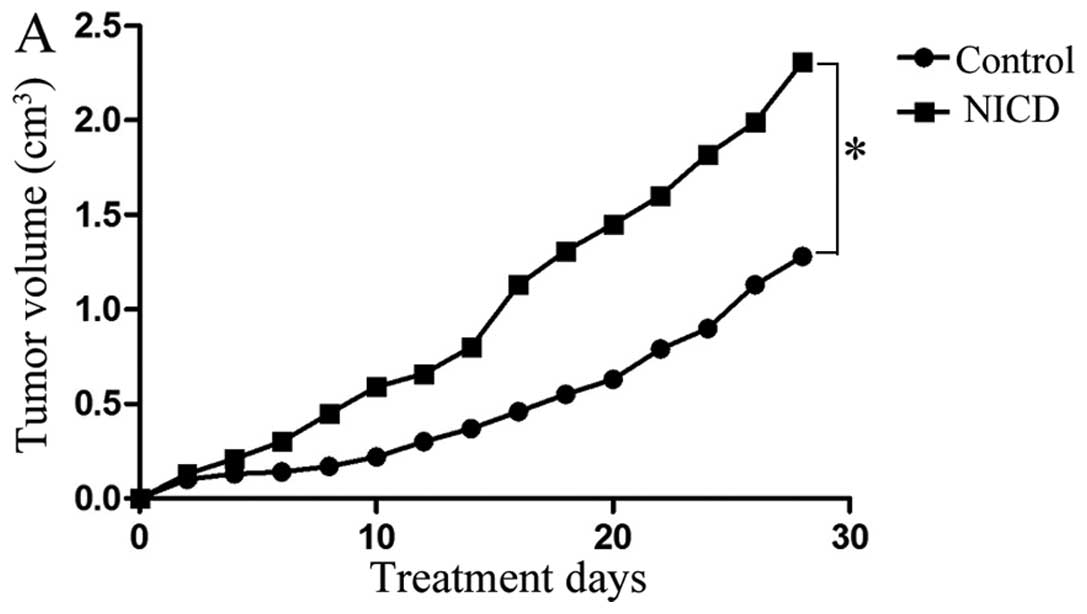Notch1 induces epithelial-mesenchymal transition and the cancer stem cell phenotype in breast cancer cells and STAT3 plays a key role
- Authors:
- Published online on: December 23, 2014 https://doi.org/10.3892/ijo.2014.2809
- Pages: 1141-1148
Abstract
Introduction
It has been established that Notch signaling plays an important role in cell proliferation and apoptosis (1). A number of studies have confirmed that Notch genes are abnormally activated in many human cancers, including breast cancer (2). In mammalian cells, activation of Notch signaling is induced through the interaction of Notch ligands, Delta-like and Jagged, with their receptors, Notch1, Notch2, Notch3 and Notch4 (3). Notch receptors are transmembrane proteins that are comprised of a large extracellular domain and a small intracellular domain (NCID). Overexpression of Notch1 or Notch4 has been shown to promote tumorigenesis in murine mammary glands (3,4). Furthermore, it has been reported that the acquisition of epithelial-mesenchymal transition (EMT), coupled to the cancer stem cell (CSC) phenotype, is induced by Notch1 overexpression in pancreatic cells (5). Finally, the generation of CSCs, which is crucial for the genesis/maintenance of cancer and probably for metastasis, is promoted by Notch signaling (6).
The process of EMT plays an important role in the development of malignant tumors. It has been shown that EMT is a pivotal step in cancer cell invasion and migration (7,8). EMT is a multistep process in which epithelial cells lose their polarity and adhesive properties and gain the migratory and invasive properties of mesenchymal cells (9). The expression of epithelial marker genes such as E-cadherin is downregulated, and the expression of mesenchymal genes such as N-cadherin and vimentin is upregulated during EMT (10,11). EMT not only facilitates tumor metastasis, but it also promotes the occurrence of CSCs in breast cancer. CSCs represent a subset of tumor cells that have a capacity for selfrenewal, tumor propagation and differentiation into multiple cell lineages (12). Mammary epithelial tumor cells that have undergone EMT have been shown to have CSC characteristics, such as the CD44+/CD24− phenotype and an accelerated selfrenewal ability (13). Although in recent years the role of EMT in tumor development has become a focus of many studies, the molecular mechanisms that control EMT have not been completely elucidated.
Signal transducer and activator of transcription 3 (STAT3) is a transcription factor that is activated by proinflammatory cytokines, growth factors and oncogenic proteins, thus regulating a variety of biological processes (14,15). The abnormal activation of STAT3 is associated with the progression of numerous human carcinomas, including breast cancer (16). Furthermore, previous studies have demonstrated that Notch activation induces EMT and the CSC phenotype through STAT3 activation (17).
The transcription factor Twist, an important regulator of EMT, is overexpressed in several cancers and regulates tumorigenesis (18–20). It has been reported that Twist is elevated through crosstalk with other pathways in breast cancer (21,22). Upregulation of the Notch receptor correlates with Twist expression in Drosophila. Moreover, Drosophila mesoderm subdivision is regulated by the Notch signaling pathway through controlling the expression Twist (23,24). A previous study confirmed that activation of the STAT3/Twist signaling pathway regulates cancer progression through crosstalk with Notch1 signaling in gastric cancer (25). Numerous studies have demonstrated that inflammatory cytokines regulate EMT and the CSC phenotype (26). However, at present, the mechanism whereby Notch1 regulates EMT and the CSC phenotype remains unclear. In this study, we investigated the effect of Notch1 signaling on EMT and CSCs, with the focus on crosstalk between Notch1, STAT3 and NF-κB signaling.
Materials and methods
Cell culture
The MCF10A and MCF7 cell lines were obtained from The Cell Bank of Shanghai (Shanghai, China). MCF7 and MCF10A cells were infected with lentiviral vector, where the HIV promoter directs the expression of NICD. The lentiviral vector was obtained from Genechem Co. Ltd. (Shanghai, China). Stable clones were selected by the limiting dilution assay and the expression level of NICD was confirmed by western blot analysis. MCF7-control and MCF7-Notch1 cells were cultured in Dulbecco’s modified Eagle’s medium (DMEM) supplemented with 10% fetal bovine serum (FBS); and MCF10A-control and MCF10A-Notch1 cells were cultured in DMEM/F12 supplemented with 5% horse serum, 0.5 μg/ml hydrocortisone, 10 μg/ml insulin (Invitrogen, Carlsbad, CA, USA) and 100 ng/ml cholera toxin (Biomal, Hamburg, Germany).
Cell proliferation assay
Cell proliferation assay was assayed by the 3-(4,5-dimethylthiazol-2yl)-2,5-diphenyltetrazolium bromide (MTT) (Sigma-Aldrich, St. Louis, MO, USA) assay. Tumor cells were seeded in 96-well plates at a density of 1,000 cell/well. After 24, 48, 72 and 96 h, 20 μl of MTT solution (5 mg/ml) was added to each well. Cells were incubated for 4 h at 37°C. The MTT was dissolved in 200 μl of dimethylsulfoxide (DMSO) and the absorbance was measured using a microplate reader at 490 nm. Wells without cells were used for the blank of the spectrophotometer. The assays were performed in triplicate for each condition and the experiments were repeated three times.
Western blot analysis
Total proteins were extracted from cells using RIPA buffer containing proteinase inhibitors for 20 min on ice and then cleared at 12,000 rpm for 20 min at 4°C. The protein concentration was measured using the Bradford assay (Sigma Chemicals, Bangalore, India). Equal amounts of total proteins were subjected to SDS-PAGE under reducing conditions followed by transfer to polyvinylidene difluoride membranes. After blocking, the membranes were incubated at 4°C overnight with the primary antibody. Antibodies specific for E-cadherin (Cell Signaling Technology, Inc.), occludin (Proteintech Group Inc.), N-cadherin (Cell Signaling Technology, Inc.), vimentin (Cell Signaling Technology, Inc.), p65 (Abcam, Cambridge, UK), fibronectin (Cell Signaling Technology, Inc.), Notch1 (Abcam), STAT3 (Proteintech Group Inc.), p-STAT3 (Epitomics, Inc.) and interleukin (IL)-1β (Cell Signaling Technology, Inc.) were used in this study. After a wash in Tris hydrochloride buffer (TBS) containing 0.1% Tween-20 (TBS-T), the membranes were incubated with an HRP-conjugated secondary antibody (Santa Cruz Biotechnology, Inc.) for 2 h at room temperature. The membranes were treated with ECL plus reagent (GE Healthcare) and exposed to X-ray film. Autoradiogram signals were documented by a gel densitometric scanning program.
Cell migration and invasion assays
For the migration assays, 8×104 cells were seeded on 8-μm transwell filters (Millipore) in 200 μl of complete medium without FBS. In the lower chamber, 500 μl of complete medium supplemented with 10% FBS was added. Cells were incubated for 12 or 24 h. For the invasion assays, the membranes were coated with Matrigel (1.5 mg/ml) and the cells were cultured for 48 h. Non-intruding cells were removed with a cotton swab. The cells that adhered to the underside of the membrane were fixed and stained with crystal violet solution. Ten random fields were counted under a bright-field microscope.
Flow cytometry
The identification of CD44+/CD24− was assayed using anti-CD44-FITC (Abcam) and anti-CD24-PE antibodies (Abcam). Cells were cultured in DMEM/F12 supplemented with 20 ng/ml EGF and 20 ng/ml FGF-β. After 2 weeks, cells were centrifuged at 1,000 rpm for 5 min and re-suspended in 100 μl of FACS buffer containing 20 μl of CD44 and CD24 antibodies for 30 min on ice. Labeled cells were analyzed by flow cytometer (BD Biosciences, San Diego, CA, USA).
Immunofluorescence assay
A total of 2×104 cells were plated on poly-L-lysine-coated coverslips in 24-well plates. After 48 h, the cells were washed with phosphate-buffered saline (PBS) and fixed with 4% paraformaldehyde for 30 min. Next, the cells were permeabilized with 0.3% Triton X-100 for 5 min. After blocking with goat serum for 30 min, the cells were incubated with a rabbit polyclonal CD24 antibody (Abcam) and a mouse polyclonal CD44 antibody (Abcam) overnight at 4°C. The slides were washed with PBS, stained with Cy3-conjugated secondary antibody for 2 h at room temperature and imaged under a fluorescence microscope (Ex and Em wavelengths were set at 550 and 620 nm, respectively, with exposure at 400 msec).
Tumor formation in vivo
Athymic nude mice (Silaike Laboratory Animal Co., Ltd., Shanghai, China) were used to assess the effect of Notch1 on tumor growth and metastasis in vivo. The animal protocol was authorized by the Animal Care and Use Committee of Xi’an Jiaotong University. Approximately 8×106 of MCF7 or MCF7-notch1 cells resuspended in 0.3 ml of serum-free medium were implanted into the fat pads of mice. Tumor growth was monitored every 2 days for 28 days. The tumor volume was calculated using the following formula: length × width2 × 0.5. The tumor tissues was removed for immunohistochemistry.
Immunohistochemistry
Fresh tissue was fixed in 4% formaldehyde and embedded into paraffin with 4-μm thickness. The slides were de-paraffinized with xylene, dehydrated through a graded alcohol series and subsequently incubated with 0.3% hydrogen peroxide for 10 min. Antigens were retrieved via heating in citrate buffer for 1 h at 95°C. The slides were incubated with hydrogen peroxide for 5 min and blocked with 10% of normal goat serum for 15 min at room temperature and then incubated with anti-E-cadherin antibody (1:100; Beijing Biosynthesis Biotechnology), anti-N-cadherin antibody (1:50; Beijing Biosynthesis Biotechnology) and anti-vimentin antibody (1:100; Beijing Biosynthesis Biotechnology) in humidified chamber overnight at 4°C, washed in PBS and incubated with secondary antibody for 15 min at 37°C, followed by incubation with streptavidin-peroxidase (Dako) for 15 min at 37°C. The slides were counterstained with hematoxylin.
Statistical methods
The data were presented as means ± standard deviation using GraphPad Prism software (version 5.0). Comparisons between the groups were analyzed using the Student’s t-test. P-values <0.05 were considered statistically significant.
Results
Notch1 overexpression promotes cell proliferation in MCF7 and MCF10A cells
Transfected cells were analyzed by western blot analysis using an anti-Notch1 antibody. We demonstrated that the expression of Notch1 was significantly increased in MCF7 and MCF10A cells (Fig. 1A). The effect of Notch1 on the growth of breast cancer cells is shown in Fig. 1B. We demonstrated that proliferation of MCF7-notch1 cells was increased at 24, 48, 72 and 96 h compared to control MCF7 cells (P<0.05). Similarly, Notch1 increased proliferation of MCF10A cells (P<0.05).
Notch1 overexpression promotes EMT
To assess the effect of Notch1 overexpression on EMT, we compared the expression of E-cadherin, occludin, N-cadherin, vimentin and fibronectin in MCF7 and MCF10A cells as well as MCF7 and MCF10A cells transfected with Notch1 by western blot analysis. We showed that Notch1 overexpression led to increased expression of N-cadherin, vimentin, and fibronectin, while the expression of E-cadherin and occludin was decreased (Fig. 2A) (P<0.05). We also found morphological changes in MCF7-notch1 and MCF10A-notch1 cells that were consistent with EMT. The cell-cell junctions were disrupted and the cells regained a fibroblast-like appearance (Fig. 2B), characteristics of the EMT phenotype. These findings suggested that overexpression of Notch1 promotes acquisition of the EMT phenotype.
Notch1 promotes the migration and invasion of MCF7 and MCF10A cells
Next, we tested the effect of Notch1 on the migration and invasion of MCF7 and MCF10A cells. As shown in Fig. 3A, Notch1 overexpression led to a 3.2-fold increase in migration of MCF7 cells (P<0.05) and a 2-fold increase in MCF10A-notch1 cells (P<0.05). In addition, we also assessed the capability of these cells to invade using a Matrigel-coated transwell assay. The expression of Notch1 increased the invasion of MCF7 cells by 2.8- (P<0.05) and 1.9-fold in MCF10A cells (P<0.05) (Fig. 3B). These results established that Notch1 promotes the migration and invasiveness of breast cancer cells. A selective JAK/STAT3 inhibitor, JSI124, decreased the migration of MCF7-notch1 cells by 2.6- (P<0.05) and by 1.7-fold in MCF10A-notch1 cells (P<0.05) (Fig. 3A). The invasion of MCF7-notch1 cells was reduced by JSI124 3.2- (P<0.05) and 1.5-fold in MCF10A-notch1 cells (P<0.05) (Fig. 3B). These results suggested that Notch1 stimulates the invasion and migration of cancer cells via STAT3.
Notch1 interacts with the STAT3 and NF-κB signaling pathways in mammary cells
In order to test our hypothesis that Notch1 induces EMT through interaction with other signaling pathways, such as STAT3, we monitored the expression of STAT3 and p-STAT3 (phospho S727) in breast cancer cells by western blot analysis. We showed that Notch1 increased the expression of p-STAT3 in MCF7 and MCF10A cells; the expression of total STAT3 was not affected by Notch1. Several studies have suggested that NF-κB signaling also influences the Notch signaling pathway (27). We demonstrated that Notch1 increased the expression of p65 and the NF-κB target gene, IL-1. As shown in previous studies, NF-κB plays a key role in the regulation of apoptosis (27). To investigate the role of STAT3 in Notch1 signaling, we inhibited STAT3 activity by the specific inhibitor JSI-124. We demonstrated that JSI124 downregulated the levels of p65 and IL-1β in MCF7-notch1 and MCF10A-notch1 cells (P<0.05). We showed that JSI124 increased the expression of E-cadherin and reduced the expression the EMT marker N-cadherin in MCF7 and MCF10A cells expressing Notch1 (P<0.05) (Fig. 4).
Notch1 overexpression promotes the expression of CSC surface markers in breast cancer cells
It has been suggested that the CSC phenotype is induced by Notch1 overexpression (6). We tested the CSC surface markers using anti-CD44 and anti-CD24 antibodies by an immunofluorescence assay. Notch1 increased the expression of CD44 and decreased the expression of CD24 (Fig. 5A). Accordingly, we demonstrated that the proportion of CD44+/CD24low cancer stem cells was increased in MCF7 and MCF10 cells upon the expression of Notch1 (Fig. 5B). Notch 1 increased the proportion of CD44+/CD24low cells from 12.41 to 28.26% in MCF7 cells and from 9.40 in to 19.21% in MCF10A cells. Thus, our data suggested that Notch1 overexpression promotes the acquisition of the breast CSC phenotype in MCF7 and MCF10A cells.
Notch1 overexpression promotes tumor growth in vivo
Next, we explored the effect of Notch1 overexpression on tumor growth and metastatic potential in vivo. Consistent with our in vitro data, we showed that MCF7 cells that overexpressed Notch1 grew significantly faster than control cells (P<0.05) (Fig. 6A), confirming that Notch1 has a positive effect on tumor growth in vivo. Immunohistochemical analysis showed that tumors derived from MCF7-notch1 cells display elevated levels of N-cadherin and vimentin, but reduced levels of E-cadherin (Fig. 6B).
Discussion
Several studies have suggested that the Notch signaling pathway regulates the progression of solid tumors (28). However, the molecular mechanism linking the Notch signaling pathway and tumorigenesis has not been completely elucidated. It has been demonstrated that the upregulation of Notch promotes the growth of lung and breast cancer cells (29,30). In this study, we showed that Notch1 overexpression enhanced the proliferation of MCF7 and MCF10A breast cancer cells. The invasion and migration of cancer cells were also promoted by Notch1 overexpression. In addition, we showed that Notch1 overexpression advanced the growth of tumor cells in vivo. All of these results are consistent with the notion that the Notch signaling pathway plays an important role in the progression of breast cancer.
Recent data have suggested that EMT is a key process in tumor progression and metastasis related to abnormal Notch signaling (31). Xie et al confirmed that the upregulation of Notch1 signaling reinforces the process of EMT in lung cancer (32). Our results showed that EMT markers, such as N-cadherin and vimentin, were upregulated, but epithelial markers (e.g., E-cadherin and occludin) were downregulated in MCF7 and MCF10A cells overexpressing Notch1. The extracellular matrix (ECM) plays an important role in mammary gland progression and breast cancer formation (33) and rearrangement of ECM proteins is a hallmark of EMT (34). Our results support this viewpoint, as we showed that fibronectin was increased in breast cancer cells undergoing EMT.
Previous reports have shown that CSCs are present in acute myeloid leukemia, breast cancer, pancreatic cancer, colon carcinoma and melanoma (35–37). EMT has been shown to generate cells with stem cell-like properties (38–40). In addition, recent studies have demonstrated that Notch signaling is involved in EMT and the generation of CSCs (41). McGowan et al have confirmed that the repression of Notch1 leads to the generation of CD44+/CD24− cells and reduces the formation of brain metastasis in breast cancer (42). Notch1 also induced EMT consistent with the CSC phenotype in pancreatic cancer cells (6). In this study, we confirmed that Notch1 regulates EMT and CSCs. The proportion of CD44+/CD24− cells was higher in MCF7 and MCF10A cells overexpressing Notch1. Furthermore, mammary gland development is regulated by various signaling pathways that regulate cell fate and cell differentiation. Notch4 and Notch3 genes have been shown to regulate normal mammary development. Indeed, Notch family members play a significant role in mammosphere formation and their ligands may affect mammary epithelial cell development (43–45). In this study, we only explored the gene function of Notch1; Notch2, Notch3 and Notch4 were not studied.
The effect of Notch signaling on CSCs is enhanced by crosstalk with other signaling pathways, such as Hedgehog and Wnt (46). Hsu et al have confirmed that activation of the Notch1/STAT3/Twist pathways is involved in the development of human gastric cancer (25). Several studies have shown that inflammatory cytokines such as IL-1 and IL-6 are important factors in Notch signaling (47,48) and that there is crosstalk between Notch and NF-κB signaling (44). Liu et al have investigated the effect of crosstalk of the Notch1, STAT3 and NF-κB signaling pathways on human epidermal tumors (27). We showed that the expression of p65 and IL-1β were increased in Notch1-overexpressing cells. To establish the role of STAT3 signaling, we used a STAT3-specific inhibitor. Strikingly, we found that the expression levels of p65 and IL-1β were downregulated upon inhibition of STAT3. Inhibition of STAT3 activity by JSI124 inhibited EMT, as shown by increased levels of E-cadherin and reduced levels of N-cadherin. In addition, inhibition of STAT3 activity also suppressed cell migration and invasion. These results suggest that STAT3 phosphorylation is a key downstream target of Notch signaling and that Notch1 induces the acquisition of EMT and the CSC phenotype in a STAT3-dependent manner.
In conclusion, our findings suggest that Notch1 plays a crucial role in breast cancer and may be a key target for cancer therapy. However, the precise mechanism of the crosstalk between Notch and other signaling pathways requires further investigations.
Acknowledgements
This study was supported by the National Natural Science Foundation of China (no. 81102027).
References
|
Wang Z, Li Y, Banerjee S and Sarkar FH: Exploitation of the Notch signaling pathway as a novel target for cancer therapy. Anticancer Res. 28:3621–3630. 2008. | |
|
Rizzo P, Osipo C, Foreman K, Golde T, Osborne B and Miele L: Rational targeting of Notch signaling in cancer. Oncogene. 27:5124–5131. 2008. View Article : Google Scholar : PubMed/NCBI | |
|
Gallahan D, Jhappan C, Robinson G, et al: Expression of a truncated Int3 gene in developing secretory mammary epithelium specifically retards lobular differentiation resulting in tumorigenesis. Cancer Res. 56:1775–1785. 1996.PubMed/NCBI | |
|
Kiaris H, Politi K, Grimm LM, et al: Modulation of notch signaling elicits signature tumors and inhibits hras1-induced oncogenesis in the mouse mammary epithelium. Am J Pathol. 165:695–705. 2004. View Article : Google Scholar : PubMed/NCBI | |
|
Bao B, Wang Z, Ali S, et al: Notch-1 induces epithelial-mesenchymal transition consistent with cancer stem cell phenotype in pancreatic cancer cells. Cancer Lett. 307:26–36. 2011. View Article : Google Scholar : PubMed/NCBI | |
|
Artavanis-Tsakonas S, Rand MD and Lake RJ: Notch signaling: cell fate control and signal integration in development. Science. 284:770–776. 1999. View Article : Google Scholar : PubMed/NCBI | |
|
Shook D and Keller R: Mechanisms, mechanics and function of epithelial-mesenchymal transitions in early development. Mech Dev. 120:1351–1383. 2003. View Article : Google Scholar : PubMed/NCBI | |
|
Thiery JP: Epithelial-mesenchymal transitions in tumour progression. Nat Rev Cancer. 2:442–454. 2002. View Article : Google Scholar : PubMed/NCBI | |
|
Levayer R and Lecuit T: Breaking down EMT. Nat Cell Biol. 10:757–759. 2008. View Article : Google Scholar : PubMed/NCBI | |
|
Kalluri R and Weinberg RA: The basics of epithelial-mesenchymal transition. J Clin Invest. 119:1420–1428. 2009. View Article : Google Scholar : PubMed/NCBI | |
|
Duband JL, Blavet C, Jarov A and Fournier-Thibault C: Spatio-temporal control of neural epithelial cell migration and epithelium-to-mesenchyme transition during avian neural tube development. Dev Growth Differ. 51:25–44. 2009. View Article : Google Scholar : PubMed/NCBI | |
|
Clevers H: The cancer stem cell: premises, promises and challenges. Nat Med. 17:313–319. 2011. View Article : Google Scholar : PubMed/NCBI | |
|
Mani SA, Guo W, Liao MJ, et al: The epithelial-mesenchymal transition generates cells with properties of stem cells. Cell. 133:704–715. 2008. View Article : Google Scholar : PubMed/NCBI | |
|
Baker SJ, Rane SG and Reddy EP: Hematopoietic cytokine receptor signaling. Oncogene. 26:6724–6737. 2007. View Article : Google Scholar : PubMed/NCBI | |
|
Groner B, Lucks P and Borghouts C: The function of Stat3 in tumor cells and their microenvironment. Semin Cell Dev Biol. 19:341–350. 2008. View Article : Google Scholar : PubMed/NCBI | |
|
Berishaj M, Gao SP, Ahmed S, et al: Stat3 is tyrosine-phosphorylated through the interleukin-6/glycoprotein 130/Janus kinase pathway in breast cancer. Breast Cancer Res. 9:R322007. View Article : Google Scholar : PubMed/NCBI | |
|
Marotta LL, Almendro V, Marusyk A, et al: The JAK2/STAT3 signaling pathway is required for growth of CD44(+) CD24(−) stem cell-like breast cancer cells in human tumors. J Clin Invest. 121:2723–2735. 2011. View Article : Google Scholar : PubMed/NCBI | |
|
Barnes RM and Firulli AB: A twist of insight - the role of Twist-family bHLH factors in development. Int J Dev Biol. 53:909–924. 2009. View Article : Google Scholar : PubMed/NCBI | |
|
Puisieux A, Valsesia-Wittmann S and Ansieau S: A twist for survival and cancer progression. Br J Cancer. 94:13–17. 2006. View Article : Google Scholar | |
|
Zeisberg M and Neilson EG: Biomarkers for epithelial-mesenchymal transitions. J Clin Invest. 119:1429–1437. 2009. View Article : Google Scholar : PubMed/NCBI | |
|
Watanabe O, Imamura H, Shimizu T, et al: Expression of twist and wnt in human breast cancer. Anticancer Res. 24:3851–3856. 2004. | |
|
Vesuna F, Lisok A, Kimble B and Raman V: Twist modulates breast cancer stem cells by transcriptional regulation of CD24 expression. Neoplasia. 11:1318–1328. 2009.PubMed/NCBI | |
|
Anant S, Roy S and VijayRaghavan K: Twist and Notch negatively regulate adult muscle differentiation in Drosophila. Development. 125:1361–1369. 1998.PubMed/NCBI | |
|
Tapanes-Castillo A and Baylies MK: Notch signaling patterns Drosophila mesodermal segments by regulating the bHLH transcription factor twist. Development. 131:2359–2372. 2004. View Article : Google Scholar : PubMed/NCBI | |
|
Hsu KW, Hsieh RH, Huang KH, et al: Activation of the Notch1/STAT3/Twist signaling axis promotes gastric cancer progression. Carcinogenesis. 33:1459–1467. 2012. View Article : Google Scholar : PubMed/NCBI | |
|
Li Y, Wang L, Pappan L, Galliher-Beckley A and Shi J: IL-1beta promotes stemness and invasiveness of colon cancer cells through Zeb1 activation. Mol Cancer. 11:872012. View Article : Google Scholar | |
|
Liu ZL, Li Y, Kong QY, et al: Immunohistochemical profiling of Wnt, NF-kappaB, Stat3 and Notch signaling in human epidermal tumors. J Dermatol Sci. 52:133–136. 2008. View Article : Google Scholar : PubMed/NCBI | |
|
Koch U, Lehal R and Radtke F: Stem cells living with a Notch. Development. 140:689–704. 2013. View Article : Google Scholar : PubMed/NCBI | |
|
Osanyingbemi-Obidi J, Dobromilskaya I, Illei PB, Hann CL and Rudin CM: Notch signaling contributes to lung cancer clonogenic capacity in vitro but may be circumvented in tumorigenesis in vivo. Mol Cancer Res. 9:1746–1754. 2011. View Article : Google Scholar : PubMed/NCBI | |
|
Bolos V, Mira E, Martinez-Poveda B, et al: Notch activation stimulates migration of breast cancer cells and promotes tumor growth. Breast Cancer Res. 15:R542013. View Article : Google Scholar : PubMed/NCBI | |
|
Espinoza I and Miele L: Deadly crosstalk: Notch signaling at the intersection of EMT and cancer stem cells. Cancer Lett. 341:41–45. 2013. View Article : Google Scholar : PubMed/NCBI | |
|
Xie M, Zhang L, He CS, et al: Activation of Notch-1 enhances epithelial-mesenchymal transition in gefitinib-acquired resistant lung cancer cells. J Cell Biochem. 113:1501–1513. 2012. | |
|
Ghajar CM and Bissell MJ: Extracellular matrix control of mammary gland morphogenesis and tumorigenesis: insights from imaging. Histochem Cell Biol. 130:1105–1118. 2008. View Article : Google Scholar : PubMed/NCBI | |
|
Park J and Schwarzbauer JE: Mammary epithelial cell interactions with fibronectin stimulate epithelial-mesenchymal transition. Oncogene. 33:1649–1657. 2014. View Article : Google Scholar : | |
|
Bonnet D and Dick JE: Human acute myeloid leukemia is organized as a hierarchy that originates from a primitive hematopoietic cell. Nat Med. 3:730–737. 1997. View Article : Google Scholar : PubMed/NCBI | |
|
Al-Hajj M, Wicha MS, Benito-Hernandez A, Morrison SJ and Clarke MF: Prospective identification of tumorigenic breast cancer cells. Proc Natl Acad Sci USA. 100:3983–3988. 2003. View Article : Google Scholar : PubMed/NCBI | |
|
Li C, Heidt DG, Dalerba P, et al: Identification of pancreatic cancer stem cells. Cancer Res. 67:1030–1037. 2007. View Article : Google Scholar : PubMed/NCBI | |
|
Mallini P, Lennard T, Kirby J and Meeson A: Epithelial-to-mesenchymal transition: what is the impact on breast cancer stem cells and drug resistance. Cancer Treat Rev. 40:341–348. 2014. View Article : Google Scholar | |
|
Castellanos JA, Merchant NB and Nagathihalli NS: Emerging targets in pancreatic cancer: epithelial-mesenchymal transition and cancer stem cells. Onco Targets Ther. 6:1261–1267. 2013.PubMed/NCBI | |
|
Takebe N, Warren RQ and Ivy SP: Breast cancer growth and metastasis: interplay between cancer stem cells, embryonic signaling pathways and epithelial-to-mesenchymal transition. Breast Cancer Res. 13:2112011. View Article : Google Scholar : PubMed/NCBI | |
|
Espinoza I, Pochampally R, Xing F, Watabe K and Miele L: Notch signaling: targeting cancer stem cells and epithelial-to-mesenchymal transition. Onco Targets Ther. 6:1249–1259. 2013.PubMed/NCBI | |
|
McGowan PM, Simedrea C, Ribot EJ, et al: Notch1 inhibition alters the CD44hi/CD24lo population and reduces the formation of brain metastases from breast cancer. Mol Cancer Res. 9:834–844. 2011. View Article : Google Scholar : PubMed/NCBI | |
|
Soriano JV, Uyttendaele H, Kitajewski J and Montesano R: Expression of an activated Notch4(int-3) oncoprotein disrupts morphogenesis and induces an invasive phenotype in mammary epithelial cells in vitro. Int J Cancer. 86:652–659. 2000. View Article : Google Scholar : PubMed/NCBI | |
|
Dontu G, Jackson KW, McNicholas E, Kawamura MJ, Abdallah WM and Wicha MS: Role of Notch signaling in cell-fate determination of human mammary stem/progenitor cells. Breast Cancer Res. 6:R605–R615. 2004. View Article : Google Scholar : PubMed/NCBI | |
|
Bellavia D, Checquolo S, Campese AF, Felli MP, Gulino A and Screpanti I: Notch3: from subtle structural differences to functional diversity. Oncogene. 27:5092–5098. 2008. View Article : Google Scholar : PubMed/NCBI | |
|
Guo S, Liu M and Gonzalez-Perez RR: Role of Notch and its oncogenic signaling crosstalk in breast cancer. Biochim Biophys Acta. 1815:197–213. 2011.PubMed/NCBI | |
|
Lin JT, Wang JY, Chen MK, et al: Colon cancer mesenchymal stem cells modulate the tumorigenicity of colon cancer through interleukin 6. Exp Cell Res. 319:2216–2229. 2013. View Article : Google Scholar : PubMed/NCBI | |
|
Wang H, Tian Y, Wang J, et al: Inflammatory cytokines induce NOTCH signaling in nucleus pulposus cells: implications in intervertebral disc degeneration. J Biol Chem. 288:16761–16774. 2013. View Article : Google Scholar : PubMed/NCBI |



